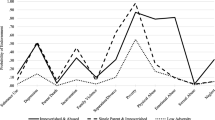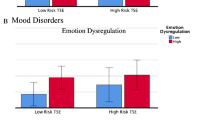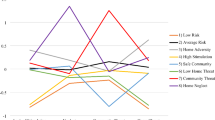Abstract
We examine the outcomes associated with childhood adversity for women with and without carefully diagnosed childhood ADHD, via an ethnically diverse sample of 140 participants with ADHD (Mage = 9.7) and 88 age- and ethnicity-matched comparisons (Mage = 9.4). At adult follow-up, we retained 211 of the original 228 participants (92.6%; Mage = 25.6). We used latent class analysis to identify patterns of childhood adversity and examine their association with adult global functioning and psychopathology. Key findings: (1) Four childhood adversity classes emerged (Low Exposure, Familial Dysfunction, Emotional Maltreatment, Pervasive Exposure); (2) Childhood ADHD predicted membership in the Emotional Maltreatment class; and (3) Childhood adversity classes were differently associated with adult outcomes, such that membership in both the Emotional Maltreatment and Pervasive Exposure classes predicted significantly higher internalizing and externalizing symptoms as well as significantly lower global functioning than women in the Low Exposure class. Furthermore, compared to the Emotional Maltreatment class, the Familial Dysfunction class had lower externalizing symptoms, whereas the Pervasive Exposure class had lower global functioning and higher internalizing symptoms by adulthood. Findings provide information about girls and women who could be targeted for intervention in terms of ADHD behavior patterns plus adverse experiences in childhood. Beyond limitations, we discuss the need to investigate the confluence of neurodevelopmental conditions and adverse child events with respect to maladaptive outcomes.
Similar content being viewed by others
References
Achenbach, T. M. (1991). Manual for the Child Behavior Checklist/4-18 and 1991 profile. University of Vermont, Department of Psychiatry.
Achenbach, T. M., & Rescorla, L. A. (2003). Manual for the ASEBA Adult Forms and Profiles. University of Vermont.
American Psychiatric Association. (2013). Diagnostic and statistical manual of mental disorders (DSM-5®): American Psychiatric Publishing
Bergman, L., & Magnusson, D. (1997). A person-oriented approach in research on developmental psychopathology. Development and Psychopathology, 9(2), 291–319. https://doi.org/10.1017/S095457949700206X
Björkenstam, E., Björkenstam, C., Jablonska, B., & Kosidou, K. (2018). Cumulative exposure to childhood adversity, and treated attention deficit/hyperactivity disorder: A cohort study of 543,650 adolescents and young adults in Sweden. Psychological Medicine, 48(3), 498–507. https://doi.org/10.1017/S0033291717001933
Biederman, J., Ball, S. W., Monuteaux, M. C., Mick, E., Spencer, T. J., McCreary, M., & Faraone, S. V. (2008). New insights into the comorbidity between ADHD and major depression in adolescent and young adult females. Journal of the American Academy of Child and Adolescent Psychiatry, 47(4), 426–434.
Biederman, J., Petty, C. R., Woodworth, K. Y., Lomedico, A., Hyder, L. L., & Faraone, S. V. (2012). Adult outcome of attention-deficit/hyperactivity disorder: A controlled 16-year follow-up study. The Journal of Clinical Psychiatry, 73(7), 941–950. https://doi.org/10.4088/JCP.11m07529
Bolck, A., Croon, M., & Hagenaars, J. (2004). Estimating latent structure models with categorical variables: One-step versus three-step estimators. Political Analysis, 12(1), 3–27. https://doi.org/10.1093/pan/mph001
Briscoe-Smith, A. M., & Hinshaw, S. P. (2006). Linkages between child abuse and attention-deficit/hyperactivity disorder in girls: Behavioral and social correlates. Child Abuse and Neglect, 30(11), 1239–1255.
Brown, N. M., Brown, S. N., Briggs, R. D., German, M., Belamarich, P. F., & Oyeku, S. O. (2017). Associations between adverse childhood experiences and ADHD diagnosis and severity. Academic Pediatrics, 17(4), 349–355. https://doi.org/10.1016/j.acap.2016.08.013
Chen, Q., Luo, W., Palardy, G. J., Glaman, R., & McEnturff, A. (2017). The efficacy of common fit indices for enumerating classes in growth mixture models when nested data structure is ignored: A Monte Carlo study. SAGE Open, 7(1), 1–19. https://doi.org/10.1177/2158244017700459
Celeux, G., & Soromenho, G. (1996). An entropy criterion for assessing the number of clusters in a mixture model. Journal of Classification, 13(2), 195–212.
Clark, S. L. (2010). Mixture modeling with behavioral data. Dissertation Abstracts International Section A: Humanities and Social Sciences, 71(4-A), 1183.
Clarkson Freeman, P. A. (2014). Prevalence and relationship between adverse childhood experiences and child behavior among young children. Infant Mental Health Journal, 35(6), 544–554. https://doi.org/10.1002/imhj.21460
Colich, N. L., Rosen, M. L., Williams, E. S., & McLaughlin, K. A. (2020). Biological aging in childhood and adolescence following experiences of threat and deprivation: A systematic review and meta-analysis. Psychological Bulletin, 146(9), 721–764. https://doi.org/10.1037/bul0000270
Collins, L. M., & Lanza, S. T. (2010). Latent class and latent transition analysis: With applications in the social, behavioral, and health sciences. Wiley.
Conway, F., Oster, M., & Szymanski, K. (2011). ADHD and complex trauma: A descriptive study of hospitalized children in an urban psychiatric hospital. Journal of Infant, Child, and Adolescent Psychotherapy, 10(1), 60–72. https://doi.org/10.1080/15289168.2011.575707
Copeland, W., Shanahan, L., Jane Costello, E., & Angold, A. (2009). Configurations of common childhood psychosocial risk factors. Journal of Child Psychology and Psychiatry and Allied Disciplines, 50(4), 451–459. https://doi.org/10.1111/j.1469-7610.2008.02005.x
Cordón, I. M., Pipe, M. E., Sayfan, L., Melinder, A., & Goodman, G. S. (2004). Memory for traumatic experiences in early childhood. Developmental Review, 24(1), 101–132. https://doi.org/10.1016/j.dr.2003.09.003
Craig, S. G., Bondi, B. C., O’Donnell, K. A., Pepler, D. J., & Weiss, M. D. (2020). ADHD and exposure to maltreatment in children and youth: A systematic review of the past 10 years. Current Psychiatry Reports, 22(12), 1–14. https://doi.org/10.1007/s11920-020-01193-w
Danese, A., & Widom, C. S. (2020). Objective and subjective experiences of child maltreatment and their relationships with psychopathology. Nature Human Behaviour, 4(8), 811–818. https://doi.org/10.1038/s41562-020-0880-3
Dvir, Y., Ford, J. D., Hill, M., & Frazier, J. A. (2014). Childhood maltreatment, emotional dysregulation, and psychiatric comorbidities. Harvard Review of Psychiatry, 22(3), 149–161. https://doi.org/10.1097/HRP.0000000000000014
Edwards, V. J., Holden, G. W., Felitti, V. J., & Anda, R. F. (2003). Relationship between multiple forms of childhood maltreatment and adult mental health in community respondents: Results from the adverse childhood experiences study. American Journal of Psychiatry, 160(8), 1453–1460.
Éthier, L. S., Lemelin, J. P., & Lacharité, C. (2004). A longitudinal study of the effects of chronic maltreatment on children’s behavioral and emotional problems. Child Abuse and Neglect, 28(12), 1265–1278. https://doi.org/10.1016/j.chiabu.2004.07.006
Evans, G. W., Li, D., & Whipple, S. S. (2013). Cumulative risk and child development. Psychological Bulletin, 139(6), 1342–1396. https://doi.org/10.1037/a0031808
Evans, S. W., Owens, J. S., & Bunford, N. (2014). Evidence-based psychosocial treatments for children and adolescents with attention-deficit/hyperactivity disorder. Journal of Clinical Child and Adolescent Psychology, 43(4), 527–551.
Faraone, S. V., & Larsson, H. (2019). Genetics of attention deficit hyperactivity disorder. Molecular Psychiatry, 24(4), 562–575.
Felitti, V. J., Anda, R. F., Nordenberg, D., Williamson, D. F., Spitz, A. M., Edwards, V., … Marks, J. S. (1998). Relationship of childhood abuse and household dysfunction to many of the leading causes of death in adults: The Adverse Childhood Experiences (ACE) Study. American Journal of Preventive Medicine, 14(4), 245–258. https://doi.org/10.1016/S0749-3797(98)00017-8
Finkelhor, D., Turner, H. A., Shattuck, A., & Hamby, S. L. (2015). Violence, crime, and abuse exposure in a national sample of children and youth: An update. JAMA Pediatrics, 167(7), 614–621.
Ford, J. D., Racusin, R., Ellis, C. G., Daviss, W. B., Reiser, J., Fleischer, A., & Thomas, J. (2000). Child maltreatment, other trauma exposure, and posttraumatic symptomatology among children with oppositional defiant and attention deficit hyperactivity disorders. Child Maltreatment, 5(3), 205–217.
Fuller-Thomson, E., & Lewis, D. A. (2015). The relationship between early adversities and attention-deficit/hyperactivity disorder. Child Abuse and Neglect, 47, 94–101. https://doi.org/10.1016/j.chiabu.2015.03.005
Goodman, G. S., Quas, J. A., Goldfarb, D., Gonzalves, L., & Gonzalez, A. (2019). Trauma and Long-Term Memory for Childhood Events: Impact Matters. Child Development Perspectives, 13(1), 3–9. https://doi.org/10.1111/cdep.12307
González, R. A., Vélez-Pastrana, M. C., McCrory, E., Kallis, C., Aguila, J., Canino, G., & Bird, H. (2019). Evidence of concurrent and prospective associations between early maltreatment and ADHD through childhood and adolescence. Social Psychiatry and Psychiatric Epidemiology, 54(6), 671–682. https://doi.org/10.1007/s00127-019-01659-0
Gordon, C. T., & Hinshaw, S. P. (2017). Parenting Stress and Youth Symptoms among Girls with and without Attention-Deficit/Hyperactivity Disorder. Parenting, 17(1), 11–29. https://doi.org/10.1080/15295192.2016.1262178
Green, J. G., McLaughlin, K. A., Berglund, P., Gruber, M. J., Sampson, N. A., Zaslavsky, A. M., & Kessler, R. C. (2010). Childhood adversities and adult psychopathology in the National Comorbidity Survey Replication (NCS-R) I: Associations with first onset of DSM-IV disorders. Archives of General Psychiatry, 62, 113–123. https://doi.org/10.1001/archgenpsychiatry.2009.186
Guendelman, M. D., Owens, E. B., Galan, C., Gard, A., & Hinshaw, S. P. (2016). Early-adult correlates of maltreatment in girls with attention-deficit/hyperactivity disorder: Increased risk for internalizing symptoms and suicidality. Development and Psychopathology, 28(1), 1–14. https://doi.org/10.1017/S0954579414001485
Gul, H., & Gurkan, C. K. (2018). Child maltreatment and associated parental factors among children with ADHD: A comparative study. Journal of Attention Disorders, 22(13), 1278–1288. https://doi.org/10.1177/1087054716658123
Hagan, M. J., Sulik, M. J., & Lieberman, A. F. (2016). Traumatic life events and psychopathology in a high risk, ethnically diverse sample of young children: A person-centered approach. Journal of Abnormal Child Psychology. https://doi.org/10.1007/s10802-015-0078-8
Hinshaw, S. P. (2002). Preadolescent girls with attention-deficit/hyperactivity disorder: I. Background characteristics, comorbidity, cognitive and social functioning, and parenting practices. Journal of Consulting and Clinical Psychology, 70(5), 1086–1098. https://doi.org/10.1037/0022-006X.70.5.1086
Hinshaw, S. P., Nguyen, P. T., O’Grady, S. M., & Rosenthal, E A. (2022). ADHD in girls and women: Underrepresentation, longitudinal processes, and key directions. Journal of Child Psychology and Psychiatry, 63, 484–496. https://doi.org/10.1111/jcpp.13480
Houston, J. E., Shevlin, M., Adamson, G., & Murphy, J. (2011). A person-centered approach to modelling population experiences of trauma and mental illness. Social Psychiatry and Psychiatric Epidemiology, 46(2), 149–157. https://doi.org/10.1007/s00127-009-0176-4
Huang, L., Dziak, J. J., Bray, B. C., & Wagner, A. T. (2017). LCA distal Stata function users’ guide (Version 1.1). University Park: The Methodology Center, Penn State.
Huang, L., Dziak, J. J., Wagner, A. T., & Lanza, S. T. (2016). LCA bootstrap Stata function users’ guide (Version 1.0). University Park: The Methodology Center, Penn State. Retrieved February 12, 2020, from http://methodology.psu.edu
King, L., Humphreys, K., Camacho, M., & Gotlib, I. (2019). A person-centered approach to the assessment of early life stress: Associations with the volume of stress-sensitive brain regions in early adolescence. Development and Psychopathology, 31(2), 643–655. https://doi.org/10.1017/S0954579418000184
Lansford, J. E., Dodge, K. A., Pettit, G. S., Bates, J. E., Crozier, J., & Kaplow, J. (2002). A 12-year prospective study of the long-term effects of early child physical maltreatment on psychological, behavioral, and academic problems in adolescence. Archives of Pediatrics and Adolescent Medicine, 156(8), 824–830.
Lanza, S. T., Dziak, J. J., Huang, L., Wagner, A. T., & Collins, L. M. (2015). LCA Stata plugin users’ guide (Version 1.2). University Park: The Methodology Center, Penn State. Retrieved August 27, 2018, from http://methodology.psu.edu.
Lewis, T., Schwebel, D. C., Elliott, M. N., Visser, S. N., Toomey, S. L., McLaughlin, K. A., & Schuster, M. A. (2015). The association between youth violence exposure and attention-deficit/hyperactivity disorder (ADHD) symptoms in a sample of fifth-graders. American Journal of Orthopsychiatry, 85(5), 504–513. https://doi.org/10.1037/ort0000081
Matthies, S., Sadohara-Bannwarth, C., Lehnhart, S., Schulte-Maeter, J., & Philipsen, A. (2018). The impact of depressive symptoms and traumatic experiences on quality of life in adults with ADHD. Journal of Attention Disorders, 22(5), 486–496. https://doi.org/10.1177/1087054716654568
McChesney, G. C., Adamson, G., & Shevlin, M. (2015). A latent class analysis of trauma based on a nationally representative sample of US adolescents. Social Psychiatry and Psychiatric Epidemiology, 50(8), 1207–1217. https://doi.org/10.1007/s00127-015-1075-5
McKelvey, L. M., Edge, N. C., Mesman, G. R., Whiteside-Mansell, L., & Bradley, R. H. (2018). Adverse experiences in infancy and toddlerhood: Relations to adaptive behavior and academic status in middle childhood. Child Abuse and Neglect, 82, 168–177. https://doi.org/10.1016/j.chiabu.2018.05.026
McLafferty, M., Armour, C., McKenna, A., O’Neill, S., Murphy, S., & Bunting, B. (2015). Childhood adversity profiles and adult psychopathology in a representative Northern Ireland study. Journal of Anxiety Disorders, 35, 42–48. https://doi.org/10.1016/j.janxdis.2015.07.004
McLaughlin, K. A. (2016). Future Directions in Childhood Adversity and Youth Psychopathology. Journal of Clinical Child & Adolescent Psychology, 45(3), 361–382. https://doi.org/10.1080/15374416.2015.1110823
McLaughlin, K.A. (2017). The long shadow of adverse childhood experiences. Psychological Science Agenda, 31(4). Retrieved February 10, 2021, from https://www.apa.org/science/about/psa/2017//adverse-childhood
McLaughlin, K. A., & Sheridan, M. A. (2016). Beyond cumulative risk: A dimensional approach to childhood adversity. Current Directions in Psychological Science, 25(4), 239–245.
McLaughlin, K. A., Green, J. G., Gruber, M. J., Sampson, N. A., Zaslavsky, A., & Kessler, R. C. (2012). Childhood adversities and first onset of psychiatric disorders in a national sample of US adolescents. Archives of General Psychiatry, 69, 1151–1160. https://doi.org/10.1001/archgenpsychiatry.2011.2277
McLaughlin, K. A., Sheridan, M. A., Winter, W., Fox, N. A., Zeanah, C. H., & Nelson, C. A. (2014). Widespread reductions in cortical thickness following severe early-life deprivation: A neurodevelopmental pathway to attention-deficit/hyperactivity disorder. Biological Psychiatry, 76(8), 629–638. https://doi.org/10.1016/j.biopsych.2013.08.016
Mersky, J. P., & Topitzes, J. (2010). Comparing early adult outcomes of maltreated and non-maltreated children: A prospective longitudinal investigation. Children and Youth Services Review, 32(8), 1086–1096. https://doi.org/10.1016/j.childyouth.2009.10.018
Northrop, J. K., & Berkowitz, S. J. (2015). Stress, trauma, and the developing brain: Oxford.
Nylund, K. L., Asparouhov, T., & Muthén, B. O. (2007). Deciding on the number of classes in latent class analysis and growth mixture modeling: A Monte Carlo simulation study. Structural Equation Modeling: A Multidisciplinary Journal, 14(4), 535–569.
Nylund-Gibson, K., Grimm, R. P., & Masyn, K. E. (2019). Prediction from Latent Classes: A Demonstration of Different Approaches to Include Distal Outcomes in Mixture Models. Structural Equation Modeling: A Multidisciplinary Journal, 26(6), 967–985. https://doi.org/10.1080/10705511.2019.1590146
Owens, E. B., Zalecki, C. A., & Hinshaw, S. P. (2016). The Berkeley Girls with ADHD Longitudinal Study (Vol. 1). Oxford University Press. https://doi.org/10.1093/med/9780190213589.003.0007
Owens, E. B., Zalecki, C., Gillette, P., & Hinshaw, S. P. (2017). Girls with childhood ADHD as adults: Cross-domain outcomes by diagnostic persistence. Journal of Consulting and Clinical Psychology, 85(7), 723.
Peleikis, D. E., Fredriksen, M., & Faraone, S. V. (2021). Childhood trauma in adults with ADHD is associated with comorbid anxiety disorders and functional impairment. Nordic Journal of Psychiatry. https://doi.org/10.1080/08039488.2021.1962973
Rinne-Albers, M. A., van der Wee, N. J., Lamers-Winkelman, F., & Vermeiren, R. R. (2013). Neuroimaging in children, adolescents and young adults with psychological trauma. European Child and Adolescent Psychiatry, 22(12), 745–755. https://doi.org/10.1007/s00787-013-0410-1
Rosen, A. L., Handley, E. D., Cicchetti, D., & Rogosch, F. A. (2018). The impact of patterns of trauma exposure among low income children with and without histories of child maltreatment. Child Abuse and Neglect, 80, 301–311. https://doi.org/10.1016/j.chiabu.2018.04.005
Sanderud, K., Murphy, S., & Elklit, A. (2016). Child maltreatment and ADHD symptoms in a sample of young adults. European Journal of Psychotraumatology, 7, 32061. https://doi.org/10.3402/ejpt.v7.32061
Sclove, L. S. (1987). Application of model-selection criteria to some problems in multivariate analysis. Psychometrika, 52, 333–343.
Shonkoff, J. P., Garner, A. S., Siegel, B. S., Dobbins, M. I., Earls, M. F., McGuinn, L., ... & Committee on Early Childhood, Adoption, and Dependent Care. (2012). The lifelong effects of early childhood adversity and toxic stress. Pediatrics, 129(1), e232–e246.
Sibley, M. H., Swanson, J. M., Arnold, L. E., Hechtman, L. T., Owens, E. B., & Stehli, A.,...& Pelham, W.E. (2017). Defining ADHD symptom persistence in adulthood: Optimizing sensitivity and specificity. Journal of Child Psychology and Psychiatry, 58, 655–662.
Sibley, M. H., Arnold, L. E., Swanson, J. M., Hechtman, L. T., Kennedy, T. M., Owens, E., ... & Rohde, L. A. (2022). Variable patterns of remission from ADHD in the Multimodal Treatment Study of ADHD. American Journal of Psychiatry, 179, 142–151.
Thornberry, T. P., Henry, K. L., Ireland, T. O., & Smith, C. A. (2010). The causal impact of childhood-limited maltreatment and adolescent maltreatment on early adult adjustment. Journal of Adolescent Health, 46(4), 359–365. https://doi.org/10.1016/j.jadohealth.2009.09.011
Tofighi, D., & Enders, C. K. (2007). Identifying the correct number of classes in growth mixture models. In G. R. Hancock & K. M. Samuelsen (Eds.), Advances in latent variable mixture models (pp. 317–341). Information Age Publishing Inc.
Wang, M.-C., Deng, Q., Bi, X., Ye, H., & Yang, W. (2017). Performance of the entropy as an index of classification accuracy in latent profile analysis: A Monte Carlo simulation study. Acta Psychologica Sinica, 49(11), 1473–1482. https:// doi.org/https://doi.org/10.3724/SP.J.1041.2017.01473
Windle, M., Haardorfer, R., Getachew, B., Shah, J., Payne, J., Pillai, D., & Berg, C. J. (2018). A multivariate analysis of adverse childhood experiences and health behaviors and outcomes among college students. Journal of American College Health, 66(4), 246–251. https://doi.org/10.1080/07448481.2018.1431892
Yang, C. C., & Yang, C. C. (2007). Separating latent classes by information criteria. Journal of Classification, 24(2), 183–203. https://doi.org/10.1007/s00357-007-0010-1
Acknowledgements
This study would not have been possible without the work of Christine A. Zalecki, Peter Gillette, and all the researchers of the Hinshaw Lab. We also wish to deeply thank the young women and their parents for their participation in our research.
Funding
The core research program described herein was funded by NIMH Grant R01450564, awarded to Stephen P. Hinshaw. The author(s) have received no additional financial support for the research, authorship, and/or publication of this article.
Author information
Authors and Affiliations
Corresponding author
Ethics declarations
Ethical Approval and Informed Consent
Informed consent was obtained from all participants, and this study was approved by the Committee for the Protection of Human Subjects at University of California, Berkeley
Conflict of Interest
The author(s) declared no potential conflicts of interest with respect to the research, authorship, and/or publication of this article.
Additional information
Publisher's Note
Springer Nature remains neutral with regard to jurisdictional claims in published maps and institutional affiliations.
Supplementary Information
Below is the link to the electronic supplementary material.
Rights and permissions
Springer Nature or its licensor (e.g. a society or other partner) holds exclusive rights to this article under a publishing agreement with the author(s) or other rightsholder(s); author self-archiving of the accepted manuscript version of this article is solely governed by the terms of such publishing agreement and applicable law.
About this article
Cite this article
Nguyen, P.T., Gordon, C.T., Owens, E.B. et al. Patterns of Childhood Adversity among Women with and without Childhood ADHD: Links to Adult Psychopathology and Global Functioning. Res Child Adolesc Psychopathol 51, 1813–1825 (2023). https://doi.org/10.1007/s10802-022-00994-2
Accepted:
Published:
Issue Date:
DOI: https://doi.org/10.1007/s10802-022-00994-2




